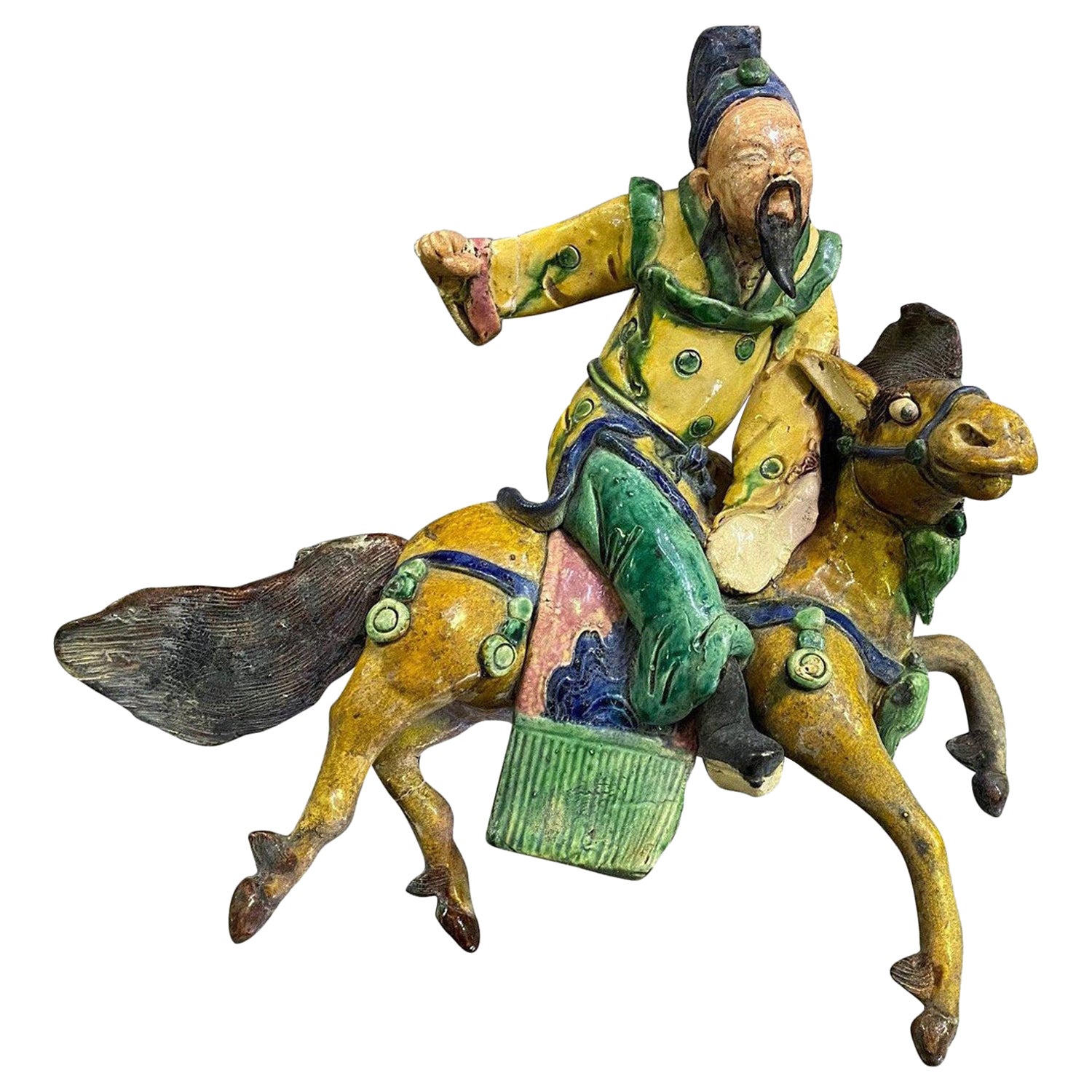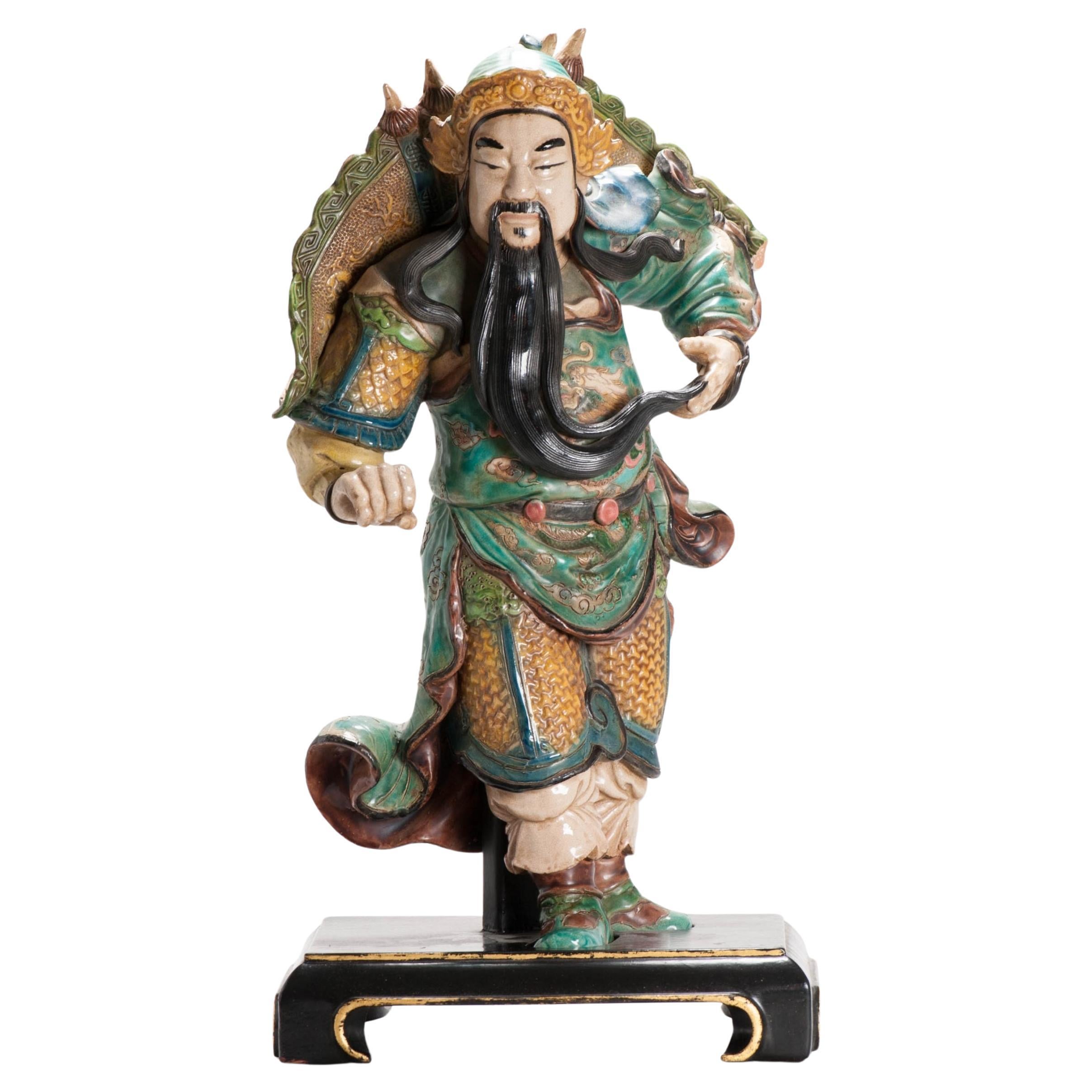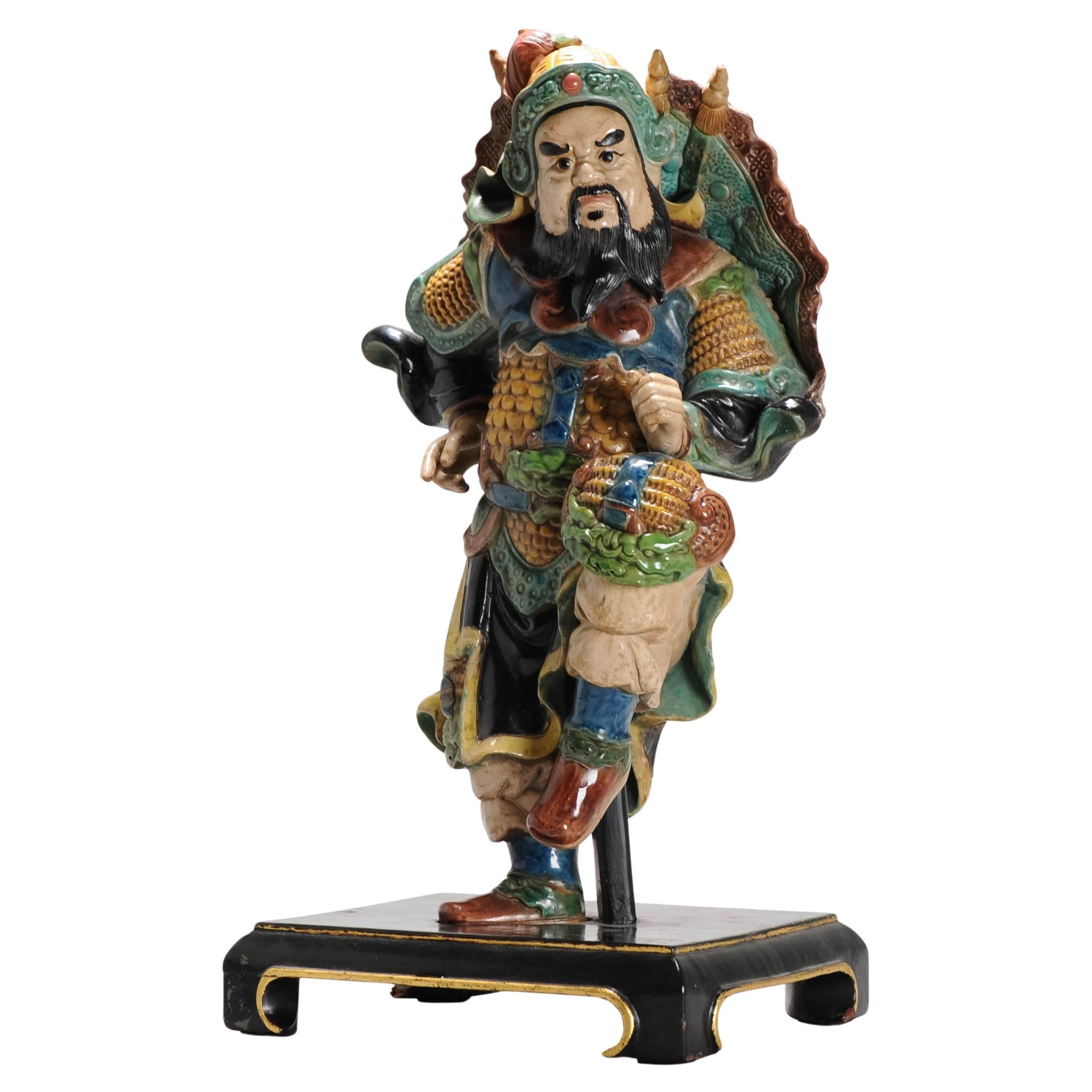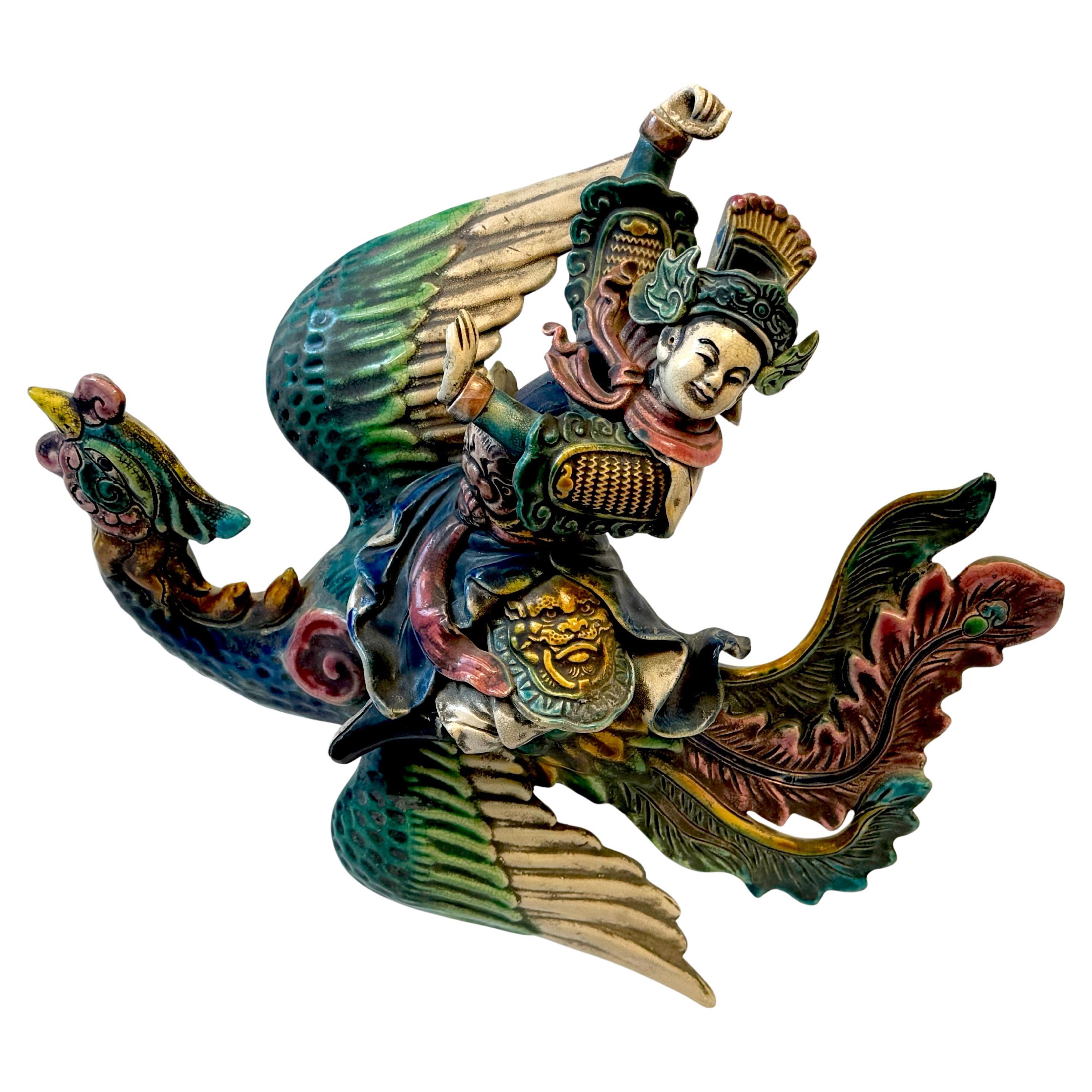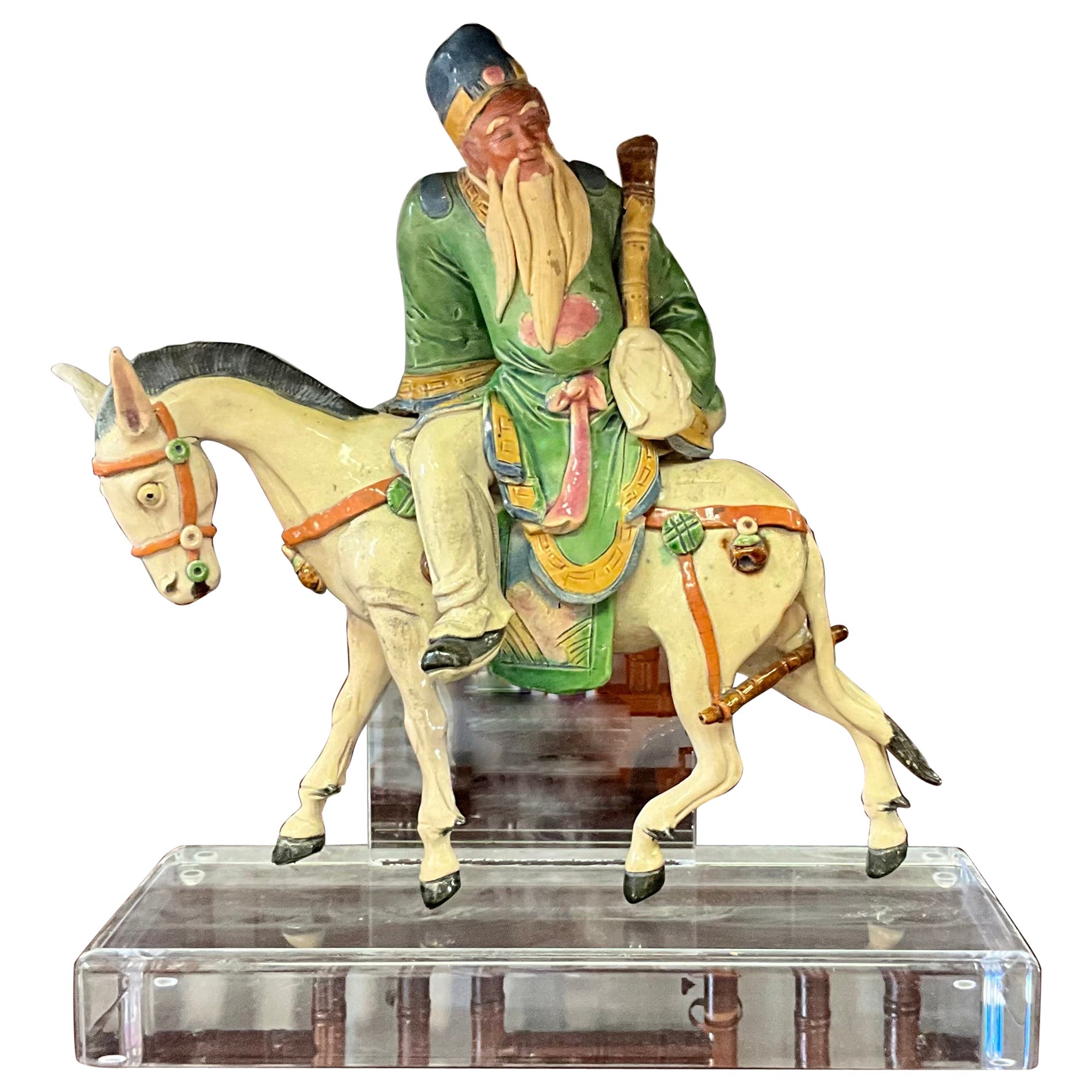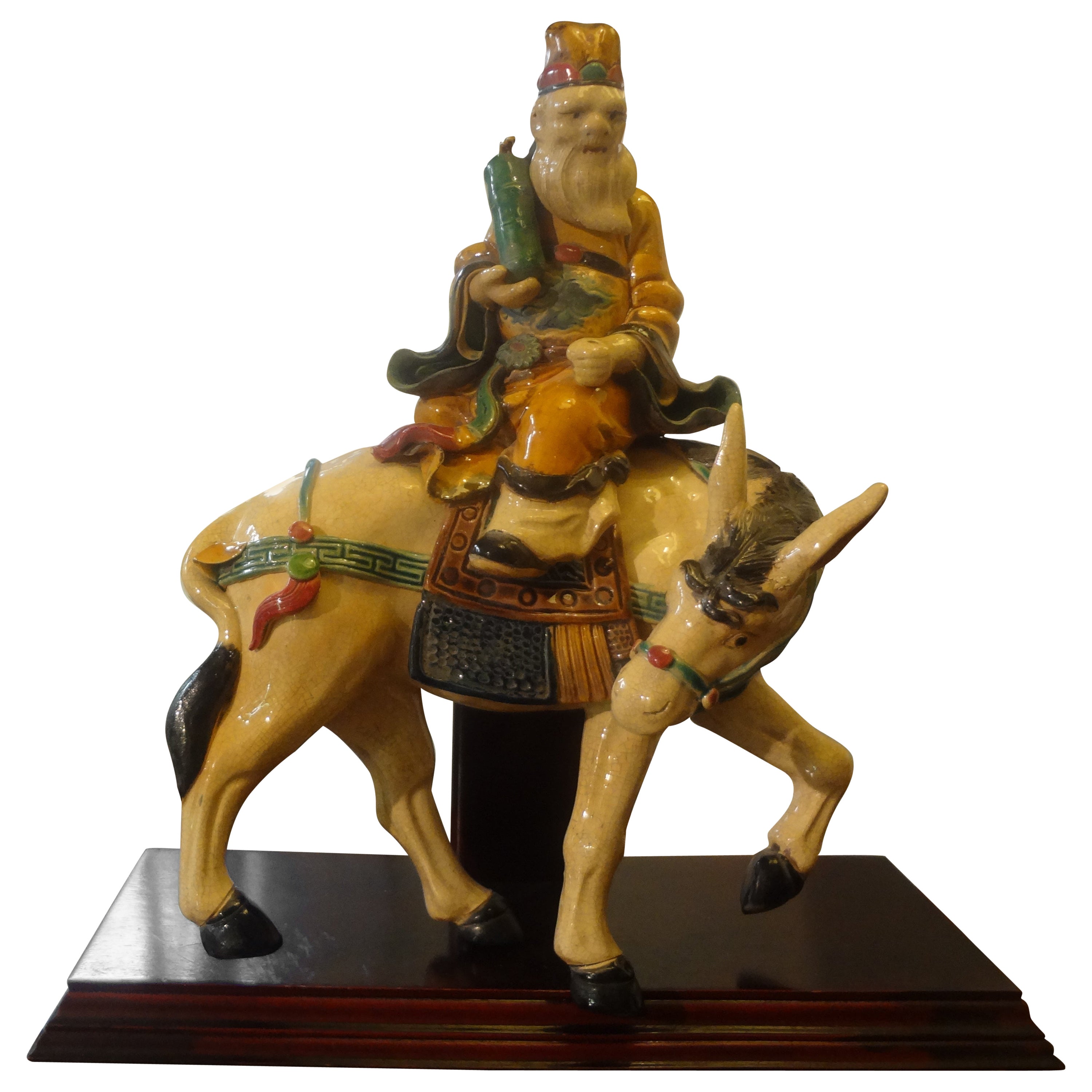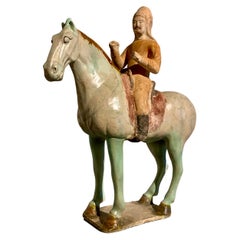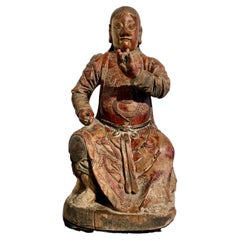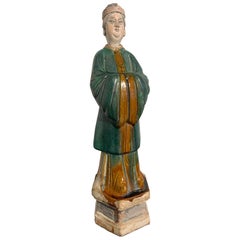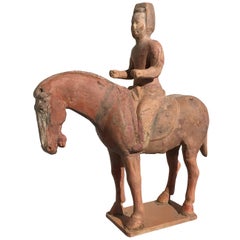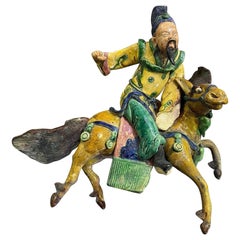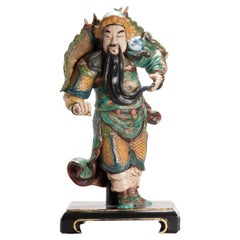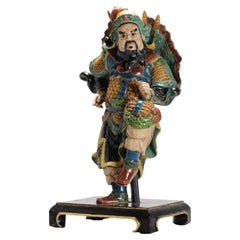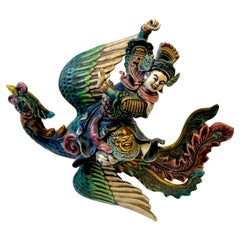Items Similar to Chinese Sancai Glazed Warrior Roof Ridge Tile, Ming Dynasty, 17th Century, China
Want more images or videos?
Request additional images or videos from the seller
1 of 14
Chinese Sancai Glazed Warrior Roof Ridge Tile, Ming Dynasty, 17th Century, China
$2,950
£2,240
€2,561.61
CA$4,121.58
A$4,584.09
CHF 2,393.67
MX$55,783.55
NOK 30,570.84
SEK 28,670.05
DKK 19,118.30
Shipping
Retrieving quote...The 1stDibs Promise:
Authenticity Guarantee,
Money-Back Guarantee,
24-Hour Cancellation
About the Item
A fantastic Chinese sancai (three color) glazed pottery roof ridge tile of an armored warrior on horseback, late Ming Dynasty (1368 to 1644), circa 1600, China.
Depicting a warrior in full military regalia riding a galloping caparisoned horse and supported by a cloud pillar, this highly expressive tileworks sculpture is full of energy and movement.
Modeled in stoneware pottery and glazed in a sancai (three color) glaze of green, yellow, and cream, this sculpture was originally created as a roof tile, and would have been set on the ridge line of a hipped roof.
The equestrian is fully armored and helmeted. A jaunty hackle rising from his heavy helmet. He sits firmly upon his mount, body slightly turned, arms extended. He originally would have been gripping a spear or polearm.
The horse is portrayed in a full gallop, supported by a cloud pillar, as if flying through the air, with back legs kicked up and mane and tail streaming behind.
All attached to a curved roof ridge tile.
- Dimensions:Height: 17.5 in (44.45 cm)Width: 17 in (43.18 cm)Depth: 6 in (15.24 cm)
- Style:Ming (Of the Period)
- Materials and Techniques:
- Place of Origin:
- Period:Early 17th Century
- Date of Manufacture:circa 1600
- Condition:Repaired: With repairs and restorations to the extremities, including the legs and tail and bridle elements of the horse, and the arms feet, and pauldrons of the figure. Wear consistent with age and use. Minor losses. Minor fading. With repairs and restorations as expected. Missing part of one arm. Missing spear. With chips and glaze losses.
- Seller Location:Austin, TX
- Reference Number:1stDibs: LU894743588052
About the Seller
5.0
Platinum Seller
Premium sellers with a 4.7+ rating and 24-hour response times
Established in 2001
1stDibs seller since 2010
345 sales on 1stDibs
Typical response time: <1 hour
- ShippingRetrieving quote...Shipping from: Austin, TX
- Return Policy
Authenticity Guarantee
In the unlikely event there’s an issue with an item’s authenticity, contact us within 1 year for a full refund. DetailsMoney-Back Guarantee
If your item is not as described, is damaged in transit, or does not arrive, contact us within 7 days for a full refund. Details24-Hour Cancellation
You have a 24-hour grace period in which to reconsider your purchase, with no questions asked.Vetted Professional Sellers
Our world-class sellers must adhere to strict standards for service and quality, maintaining the integrity of our listings.Price-Match Guarantee
If you find that a seller listed the same item for a lower price elsewhere, we’ll match it.Trusted Global Delivery
Our best-in-class carrier network provides specialized shipping options worldwide, including custom delivery.More From This Seller
View AllChinese Tang Dynasty Sancai Glazed Horse and Rider, TL Tested, China
Located in Austin, TX
A fine and unusual Chinese Tang Sancai glazed model of a horse and rider, Tang Dynasty (618 to 906 CE), early 8th century, China.
This fantastic sculpture portrays a male figures se...
Category
Antique 15th Century and Earlier Chinese Tang Antiquities
Materials
Earthenware, Pottery
Chinese Carved and Lacquered Figure of Zhenwu, Qing Dynasty, 19th century, China
Located in Austin, TX
A powerful Chinese figure of the Taoist diety Zhenwu (Xuanwu), carved and lacquered wood with applied lacquer details, Qing Dynasty, 19th century or earlier, China.
Zhenwu, also kno...
Category
Antique 19th Century Chinese Qing Sculptures and Carvings
Materials
Wood, Hardwood
Chinese Ming Dynasty Glazed Tall Attendant Figure, 16th-17th Century, China
Located in Austin, TX
A tall Chinese green and amber glazed figure of an attendant, Ming Dynasty, 16th-17th century, China.
The figure stands upon an integral plinth, dressed in long robes...
Category
Antique 17th Century Chinese Ming Sculptures and Carvings
Materials
Pottery
Tang Dynasty Painted Pottery Horse and Rider, TL Tested
Located in Austin, TX
A charming Tang dynasty painted pottery figure of a horse and mounted noble rider. TL tested by Oxford Authentication.
The horse portrayed standing fours...
Category
Antique 15th Century and Earlier Chinese Tang Antiquities
Materials
Earthenware
Pair of Tang Dynasty Sancai Glazed Tomb Guardians, Zhenmushou, 7th-8th Century
Located in Austin, TX
A fantastic and powerful pair of Chinese Tang Dynasty three-color (sancai) glazed zhenmushou, tomb guardian figures, late 7th or early 8th century. TL t...
Category
Antique 15th Century and Earlier Chinese Tang Sculptures and Carvings
Materials
Earthenware
Pair Large Chinese Ming Dynasty Glazed and Painted Pottery Figures, 16th Century
Located in Austin, TX
A striking pair of large Chinese glazed and painted pottery figures, Ming Dynasty (1368 to 1644), circa 16th century, China.
The impressive and realistically modeled figures each portrayed standing upright upon a sancai (three color) glazed pedestal of kang table form.
The man is dressed in a short black surcoat over a long robe and pants, a smart cap upon his head. His face is warm and welcoming, with wide eyes and a slight smile on his lips. He holds his hands out in front of him, palms up, almost as if shrugging, though presumably originally holding an object or offering, now lost.
The woman of slightly smaller stature, and dressed in a longer surcoat over a long robe and skirt. She wears a fitted cap upon her head. Her hands also held out in front, grasping long lost objects. Her face is slightly more severe, with a somewhat pinched look, and slight frown upon her lips.
The size of these figures is remarkable, as is the realism and attention to detail, almost as if they were modeled after real people, as opposed to the more common and generic Ming Dynasty pottery...
Category
Antique 16th Century Chinese Ming Sculptures and Carvings
Materials
Pottery
You May Also Like
Chinese Glazed Ceramic Pottery Guardian Ancestor Roof Tile Qing Figure on Horse
Located in Studio City, CA
A fantastic piece. Wonderfully glazed and colored work of a seated man with brightly colored robes riding a mythical galloping horse.
We believe this is Qing Dynasty (1644-1912) ...
Category
Early 20th Century Chinese Qing Ceramics
Materials
Ceramic, Pottery
Antique Chinese Glazed Porcelain Roof Tile of a Warrior Figure, 19th C
Located in Amsterdam, Noord Holland
Chinese glazed porcelain roof tile of a warrior. The manufacture of glazed tiles was standardized in the Ming Dynasty and during the Qing Dynasty into the Republican Era, glazed tile...
Category
Antique 19th Century Chinese Qing Sculptures and Carvings
Materials
Porcelain
$2,666 Sale Price
20% Off
Antique Chinese Glazed Porcelain Roof Tile of a Warrior Figure, 19th Century
Located in Amsterdam, Noord Holland
Chinese glazed porcelain roof tile of a warrior. The manufacture of glazed tiles was standardized in the Ming Dynasty and during the Qing Dynasty into the Republican Era, glazed tile...
Category
Antique 19th Century Chinese Qing Figurative Sculptures
Materials
Porcelain
Chinese Polychrome Decorated Roof Tile, Warrior on Phoenix
Located in Bradenton, FL
Chinese Polychrome Decorated Roof Tile affixed to acrylic stands. Whimsical Chinese tile depicting a Warrior on a Phoenix, These tiles were historically used in roofing on traditiona...
Category
Early 20th Century Chinese Chinese Export Architectural Elements
Materials
Pottery
Early 20th-C. Chinese Warrior Terracotta Roof Tile Mounted On Lucite
Located in Kennesaw, GA
This is an antique Chinese warrior roof tile that has been mounted on lucite. The composition appears to be glazed terracotta. The piece coul...
Category
Early 20th Century Chinese Chinese Export Mounted Objects
Materials
Terracotta, Lucite
Late 19th-Early 20th Century Chinese Roof Tile
Located in Houston, TX
Late 19th-Early 20th Century Chinese Roof Tile.
Our lovely antique Chinese glazed pottery or porcelain roof tile depicts a warrior riding on a donke...
Category
Antique Late 19th Century Chinese Chinese Export Ceramics
Materials
Pottery
